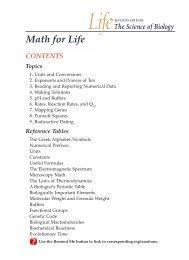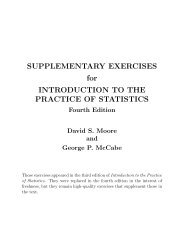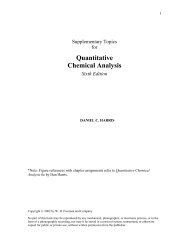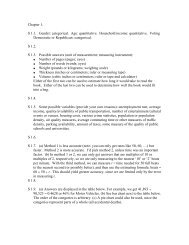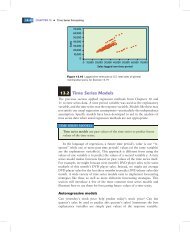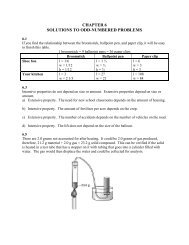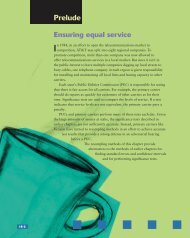Type: multiple choice Title: Chapter 17 - Question 01 ... - WH Freeman
Type: multiple choice Title: Chapter 17 - Question 01 ... - WH Freeman
Type: multiple choice Title: Chapter 17 - Question 01 ... - WH Freeman
You also want an ePaper? Increase the reach of your titles
YUMPU automatically turns print PDFs into web optimized ePapers that Google loves.
<strong>Type</strong>: <strong>multiple</strong> <strong>choice</strong><strong>Title</strong>: <strong>Chapter</strong> <strong>17</strong> - <strong>Question</strong> <strong>01</strong>1) Use the following data to calculate the lattice enthalpy at 298 K oflithium fluoride, LiF(s). All values refer to a temperature of 298 K.Enthalpy of sublimation of Li(s): +159 kJ mol –1Ionization enthalpy of Li(g): +520 kJ mol –1Enthalpy of dissociation of F 2 (g): +155 kJ mol –1Enthalpy of electron attachment to F(g): –328 kJ mol –1Enthalpy of formation of LiF(s) from Li(s) and F 2 (g): –6<strong>17</strong> kJ mol –1Correct a.# 1046 kJ mol –1Feedback: The information provided is sufficient to allow us to construct a Born–Habercycle to determine the lattice enthalpy. The method follows that used in Example <strong>17</strong>.1.Thus∆ 159 520 ½ 155 328 6<strong>17</strong> kJ mol Note that the enthalpy of dissociation of F 2 is the value for the processF 2 (g) 2F(g)which yields two F atoms. We require the enthalpy change for the process½F 2 (g) F(g)It is therefore necessary to include only half of the dissociation enthalpy of F 2 in the cycle.Page reference: 397–8incorrect b.# 1123 kJ mol –1Feedback: The information provided is sufficient to allow us to construct a Born–Habercycle to determine the lattice enthalpy. The method follows that used in Example <strong>17</strong>.1.Thus∆ 159 520 ½ 155 328 6<strong>17</strong> kJ mol Note that the enthalpy of dissociation of F 2 is the value for the processF 2 (g) 2F(g)which yields two F atoms. We require the enthalpy change for the process½F 2 (g) F(g)It is therefore necessary to include only half of the dissociation enthalpy of F 2 in the cycle.Page reference: 397–8incorrect c.# <strong>17</strong>02 kJ mol –1Feedback: The information provided is sufficient to allow us to construct a Born–Habercycle to determine the lattice enthalpy. The method follows that used in Example <strong>17</strong>.1.Thus∆ 159 520 ½ 155 328 6<strong>17</strong> kJ mol Note that the enthalpy of dissociation of F 2 is the value for the processF 2 (g) 2F(g)which yields two F atoms. We require the enthalpy change for the process½F 2 (g) F(g)It is therefore necessary to include only half of the dissociation enthalpy of F 2 in the cycle.Page reference: 397–8incorrect d.# 468 kJ mol –1Feedback: The information provided is sufficient to allow us to construct a Born–Habercycle to determine the lattice enthalpy. The method follows that used in Example <strong>17</strong>.1.Thus∆ 159 520 ½ 155 328 6<strong>17</strong> kJ mol Note that the enthalpy of dissociation of F 2 is the value for the processF 2 (g) 2F(g)which yields two F atoms. We require the enthalpy change for the process½F 2 (g) F(g)It is therefore necessary to include only half of the dissociation enthalpy of F 2 in the cycle.Page reference: 397–8END OF QUESTION
<strong>Type</strong>: <strong>multiple</strong> <strong>choice</strong><strong>Title</strong>: <strong>Chapter</strong> <strong>17</strong> - <strong>Question</strong> 022) Calculate the lattice enthalpy of calcium bromide, CaBr 2 (s), at 298 Kusing the following data. All values are for a temperature of 298 K.Enthalpy of fusion of Ca(s): +7.8 kJ mol –1Enthalpy of vaporization of Ca(l): +<strong>17</strong>0.0 kJ mol –1Ionization enthalpy of Ca(g): +595.9 kJ mol –1Ionization enthalpy of Ca + (g): +1151.1 kJ mol –1Enthalpy of atomization of Br 2 (l): +223.8 kJ mol –1Enthalpy of electron attachment to Br(g): –330.7 kJ mol –1Enthalpy of formation of CaBr 2 (s) from Ca(s) and Br 2 (g): –524.3 kJ mol –1incorrect a.# 2530.3 kJ mol –1Feedback: We should use a Born–Haber cycle to calculate the lattice energy, followingthe approach used in Example <strong>17</strong>.1. In this case, however, we are given the enthalpy ofatomization of Br 2 (l), which is the enthalpy change for the processBr 2 (l) 2 Br(g)and is equivalent to the sum of the enthalpy of vaporization and the enthalpy ofdissociation. Thus∆ 7.8 <strong>17</strong>0.0 595.9 1151.1 223.8 2 330.7 524.3 kJ mol . Page reference: 397–8incorrect b.# 2085.7 kJ mol –1Feedback: We should use a Born–Haber cycle to calculate the lattice energy, followingthe approach used in Example <strong>17</strong>.1. In this case, however, we are given the enthalpy ofatomization of Br 2 (l), which is the enthalpy change for the processBr 2 (l) 2 Br(g)and is equivalent to the sum of the enthalpy of vaporization and the enthalpy ofdissociation. Thus∆ 7.8 <strong>17</strong>0.0 595.9 1151.1 223.8 2 330.7 524.3 kJ mol . Page reference: 397–8Correct c.# 2<strong>01</strong>1.5 kJ mol –1Feedback: We should use a Born–Haber cycle to calculate the lattice energy, followingthe approach used in Example <strong>17</strong>.1. In this case, however, we are given the enthalpy ofatomization of Br 2 (l), which is the enthalpy change for the processBr 2 (l) 2 Br(g)and is equivalent to the sum of the enthalpy of vaporization and the enthalpy ofdissociation. Thus∆ 7.8 <strong>17</strong>0.0 595.9 1151.1 223.8 2 330.7 524.3 kJ mol . Page reference: 397–8incorrect d.# 2342.2 kJ mol –1Feedback: We should use a Born–Haber cycle to calculate the lattice energy, followingthe approach used in Example <strong>17</strong>.1. In this case, however, we are given the enthalpy ofatomization of Br 2 (l), which is the enthalpy change for the processBr 2 (l) 2 Br(g)and is equivalent to the sum of the enthalpy of vaporization and the enthalpy ofdissociation. Thus∆ 7.8 <strong>17</strong>0.0 595.9 1151.1 223.8 2 330.7 524.3 kJ mol . Page reference: 397–8END OF QUESTION
<strong>Type</strong>: <strong>multiple</strong> <strong>choice</strong><strong>Title</strong>: <strong>Chapter</strong> <strong>17</strong> - <strong>Question</strong> 033) Potassium bromide has a sodium chloride crystal structure withnearest neighbour ions separated by 3.29 Å. Use the Born–Mayerequation to estimate the lattice energy of potassium bromide, KBr.The Madelung constant for crystals with a sodium chloride structure is1.748.incorrect a.# 815 kJ mol –1Feedback: The Born–Mayer equation, eqn <strong>17</strong>.5∆ L | | A 4 1 allows an estimate of the lattice energy of a crystal to be calculated if the structure andseparation between ions is known. It is usual to take the value of the parameter d as34.5 pm and for a crystal with a sodium chloride structure, the Madelung constant isA = 1.748. Thus for potassium bromide∆ L |1 1| 6.022 10 mol 1.602 10 C 4 8.854 10 F m 3.2910 m 134.5 10 m3.29 10 m 1.7481422 10 J mol 0.895 1.748 The accepted literature value for the lattice enthalpy of potassium bromide at 298 K is689 kJ mol –1 .Page reference: 398–399incorrect b.# 752 kJ mol –1Feedback: The Born–Mayer equation, eqn <strong>17</strong>.5∆ L | | A 4 1 allows an estimate of the lattice energy of a crystal to be calculated if the structure andseparation between ions is known. It is usual to take the value of the parameter d as34.5 pm and for a crystal with a sodium chloride structure, the Madelung constant isA = 1.748. Thus for potassium bromide∆ L |1 1| 6.022 10 mol 1.602 10 C 4 8.854 10 F m 3.2910 m 134.5 10 m3.29 10 m 1.7481422 10 J mol 0.895 1.748 The accepted literature value for the lattice enthalpy of potassium bromide at 298 K is689 kJ mol –1 .Page reference: 398–399incorrect c.# 900 kJ mol –1Feedback: The Born–Mayer equation, eqn <strong>17</strong>.5∆ L | | A 4 1 allows an estimate of the lattice energy of a crystal to be calculated if the structure andseparation between ions is known. It is usual to take the value of the parameter d as34.5 pm and for a crystal with a sodium chloride structure, the Madelung constant isA = 1.748. Thus for potassium bromide∆ L |1 1| 6.022 10 mol 1.602 10 C 4 8.854 10 F m 3.2910 m 134.5 10 m3.29 10 m 1.7481422 10 J mol 0.895 1.748 The accepted literature value for the lattice enthalpy of potassium bromide at 298 K is689 kJ mol –1 .Page reference: 398–399Correct d.# 660 kJ mol –1
Feedback: The Born–Mayer equation, eqn <strong>17</strong>.5∆ L | | A 4 1 allows an estimate of the lattice energy of a crystal to be calculated if the structure andseparation between ions is known. It is usual to take the value of the parameter d as34.5 pm and for a crystal with a sodium chloride structure, the Madelung constant isA = 1.748. Thus for potassium bromide∆ L |1 1| 6.022 10 mol 1.602 10 C 4 8.854 10 F m 3.2910 m 134.5 10 m3.29 10 m 1.7481422 10 J mol 0.895 1.748 The accepted literature value for the lattice enthalpy of potassium bromide at 298 K is689 kJ mol –1 .Page reference: 398–399END OF QUESTION
<strong>Type</strong>: <strong>multiple</strong> <strong>choice</strong><strong>Title</strong>: <strong>Chapter</strong> <strong>17</strong> - <strong>Question</strong> 044) The magnetic susceptibilities of some metals at 298 K are givenbelow. Which of the compounds is paramagnetic?Sodium = +7.3 10 –6Aluminium = +22 10 –6Copper = –96 10 –6Platinum = +262 10 –6incorrect a.# AluminiumFeedback: Paramagnetic materials are those that tend to move into a magnetic field.The magnetic susceptibility of a paramagnetic material is therefore positive. Thussodium, aluminium and platinum are all paramagnetic. Copper is a diamagnetic material.Diamagnetic materials tend to move out of a magnetic field. The magnetic susceptibilityof diamagnetic materials is therefore negative.Page reference: 400Correct b.# Sodium, Aluminium and PlatinumFeedback: Paramagnetic materials are those that tend to move into a magnetic field.The magnetic susceptibility of a paramagnetic material is therefore positive. Thussodium, aluminium and platinum are all paramagnetic. Copper is a diamagnetic material.Diamagnetic materials tend to move out of a magnetic field. The magnetic susceptibilityof diamagnetic materials is therefore negative.Page reference: 400incorrect c.# CopperFeedback: Paramagnetic materials are those that tend to move into a magnetic field.The magnetic susceptibility of a paramagnetic material is therefore positive. Thussodium, aluminium and platinum are all paramagnetic. Copper is a diamagnetic material.Diamagnetic materials tend to move out of a magnetic field. The magnetic susceptibilityof diamagnetic materials is therefore negative.Page reference: 400incorrect d.# Copper and PlatinumFeedback: Paramagnetic materials are those that tend to move into a magnetic field.The magnetic susceptibility of a paramagnetic material is therefore positive. Thussodium, aluminium and platinum are all paramagnetic. Copper is a diamagnetic material.Diamagnetic materials tend to move out of a magnetic field. The magnetic susceptibilityof diamagnetic materials is therefore negative.Page reference: 400END OF QUESTION
<strong>Type</strong>: <strong>multiple</strong> <strong>choice</strong><strong>Title</strong>: <strong>Chapter</strong> <strong>17</strong> - <strong>Question</strong> 055) The figure shows a three-dimensional representation of the unit cell ofbarium.To which Bravais lattice type does it belong?incorrect a.# Cubic PFeedback: The fourteen different types of Bravais lattice are shown in Fig. <strong>17</strong>.22.Comparison of the structure shown for barium with these different lattices shows that it isa body-centred cubic unit cell, which is designated Cubic I.Page reference: 404Correct b.# Cubic IFeedback: The fourteen different types of Bravais lattice are shown in Fig. <strong>17</strong>.22.Comparison of the structure shown for barium with these different lattices shows that it isa body-centred cubic unit cell, which is designated Cubic I.Page reference: 404incorrect c.# Cubic FFeedback: The fourteen different types of Bravais lattice are shown in Fig. <strong>17</strong>.22.Comparison of the structure shown for barium with these different lattices shows that it isa body-centred cubic unit cell, which is designated Cubic I.Page reference: 404incorrect d.# HexagonalFeedback: The fourteen different types of Bravais lattice are shown in Fig. <strong>17</strong>.22.Comparison of the structure shown for barium with these different lattices shows that it isa body-centred cubic unit cell, which is designated Cubic I.Page reference: 404END OF QUESTION
<strong>Type</strong>: <strong>multiple</strong> <strong>choice</strong><strong>Title</strong>: <strong>Chapter</strong> <strong>17</strong> - <strong>Question</strong> 066) Assign a set of Miller indices to the lattice planes shown.incorrect a.# (120)Feedback: We should use the method described in Section <strong>17</strong>.11 to assign the Millerindices for the planes. We must first determine the smallest intersection distances oneach axis. The plane that intersects the a axis at a distance of 1a intersects the b axis at2b. The planes are parallel to the c axis so the intersection distance on this axis iseffectively infinite. The intersection distances are therefore (1a, 2b, ∞), or just (1, 2, ∞).The Miller indices are just the reciprocals of these intersection distances, expressed asintegers, (210).Page reference: 404–405incorrect b.# (220)Feedback: We should use the method described in Section <strong>17</strong>.11 to assign the Millerindices for the planes. We must first determine the smallest intersection distances oneach axis. The plane that intersects the a axis at a distance of 1a intersects the b axis at2b. The planes are parallel to the c axis so the intersection distance on this axis iseffectively infinite. The intersection distances are therefore (1a, 2b, ∞), or just (1, 2, ∞).The Miller indices are just the reciprocals of these intersection distances, expressed asintegers, (210).Page reference: 404–405Correct c.# (210)Feedback: We should use the method described in Section <strong>17</strong>.11 to assign the Millerindices for the planes. We must first determine the smallest intersection distances oneach axis. The plane that intersects the a axis at a distance of 1a intersects the b axis at2b. The planes are parallel to the c axis so the intersection distance on this axis iseffectively infinite. The intersection distances are therefore (1a, 2b, ∞), or just (1, 2, ∞).The Miller indices are just the reciprocals of these intersection distances, expressed asintegers, (210).Page reference: 404–405incorrect d.# (110)Feedback: We should use the method described in Section <strong>17</strong>.11 to assign the Millerindices for the planes. We must first determine the smallest intersection distances oneach axis. The plane that intersects the a axis at a distance of 1a intersects the b axis at2b. The planes are parallel to the c axis so the intersection distance on this axis iseffectively infinite. The intersection distances are therefore (1a, 2b, ∞), or just (1, 2, ∞).The Miller indices are just the reciprocals of these intersection distances, expressed asintegers, (210).Page reference: 404–405END OF QUESTION
<strong>Type</strong>: <strong>multiple</strong> <strong>choice</strong><strong>Title</strong>: <strong>Chapter</strong> <strong>17</strong> - <strong>Question</strong> 077) Rutile, the high-temperature form of titanium oxide, TiO 2 , adopts atetragonal P structure with a = 4.59 Å and c = 2.96 Å. Calculate theseparation between the planes with the Miller indices (111).Correct a.# 2.19 ÅFeedback: The separation between lattice planes may be calculated using eqn <strong>17</strong>.71 Because rutile adopts a tetragonal structure b = a, so that1 14.59 1 4.59 1 2.96 0.209 so thatPage reference: 405incorrect b.# 7.13 Å. Feedback: The separation between lattice planes may be calculated using eqn <strong>17</strong>.71 Because rutile adopts a tetragonal structure b = a, so that1 14.59 1 4.59 1 2.96 0.209 so thatPage reference: 405incorrect c.# 5.27 Å. Feedback: The separation between lattice planes may be calculated using eqn <strong>17</strong>.71 Because rutile adopts a tetragonal structure b = a, so that1 14.59 1 4.59 1 2.96 0.209 so thatPage reference: 405incorrect d.# 2.26 Å. Feedback: The separation between lattice planes may be calculated using eqn <strong>17</strong>.71 Because rutile adopts a tetragonal structure b = a, so that1 14.59 1 4.59 1 2.96 0.209 so thatPage reference: 405END OF QUESTION.
<strong>Type</strong>: <strong>multiple</strong> <strong>choice</strong><strong>Title</strong>: <strong>Chapter</strong> <strong>17</strong> - <strong>Question</strong> 088) Calculate the glancing angle at which diffraction from the crystalplanes with a spacing of 3.462 Å is observed when CuK radiation ofenergy 8054 eV is used as the X-ray source. incorrect a.# 2.0°Feedback: The angle of diffraction may be calculated by rearranging Bragg’s law, eqn<strong>17</strong>.82sinsin 2 To calculate the wavelength of the radiation used, we must remember that and therefore We must also convert from units of electronvolts to joules using 1 eV = 1.602 10 –19 J.Thus 6.626 10 J s 2.998 10 m s 8054 1.602 10 1.540 10 mJso thatsin 1.540 10 m. °Page reference: 408Correct b.# 12.9°2 3.462 10 mFeedback: The angle of diffraction may be calculated by rearranging Bragg’s law, eqn<strong>17</strong>.82sinsin 2 To calculate the wavelength of the radiation used, we must remember that and therefore We must also convert from units of electronvolts to joules using 1 eV = 1.602 10 –19 J.Thus 6.626 10 J s 2.998 10 m s 8054 1.602 10 1.540 10 mJso thatsin 1.540 10 m. °2 3.462 10 mPage reference: 408incorrect c.# 0.225°Feedback: The angle of diffraction may be calculated by rearranging Bragg’s law, eqn<strong>17</strong>.82sinsin 2 To calculate the wavelength of the radiation used, we must remember that and therefore
We must also convert from units of electronvolts to joules using 1 eV = 1.602 10 –19 J.Thus 6.626 10 J s 2.998 10 m s 8054 1.602 10 1.540 10 mJso thatsin 1.540 10 m2 3.462 10 . °mBe careful to check whether your calculator is using radians or degrees when performingcalculations that involve trigonometric functions.Page reference: 408incorrect d.# 26.4°Feedback: The angle of diffraction may be calculated by rearranging Bragg’s law, eqn<strong>17</strong>.82sinsin 2 To calculate the wavelength of the radiation used, we must remember that and therefore We must also convert from units of electronvolts to joules using 1 eV = 1.602 10 –19 J.Thus 6.626 10 J s 2.998 10 m s 8054 1.602 10 1.540 10 mJso thatsin 1.540 10 m. °Page reference: 408END OF QUESTION2 3.462 10 m
<strong>Type</strong>: <strong>multiple</strong> <strong>choice</strong><strong>Title</strong>: <strong>Chapter</strong> <strong>17</strong> - <strong>Question</strong> 099) In an experiment to determine the unit-cell dimensions of crsytallinemagnesium fluoride, MgF 2 , which has a tetragonal crystal lattice,CuK radiation of wavelength 154 pm was used to record the X-raydiffraction pattern. Diffraction was observed from the (110) planes ata glancing angle of 13.6° and from the (211) planes at 26.8°.Calculate the separations between the planes and hence determinethe dimensions of the unit cell.Correct a.# a = 4.62 Å, c = 3.04 ÅFeedback: For each set of planes, the separation may be determined rearrangingBragg’s law, eqn <strong>17</strong>.82sinso that2sin and hence for the (110) planes 154 10 m 3.27 10 m 3.27 Å2 sin 13.6°and for the (211) planes 154 10 m 1.71 10 m 1.71 Å2 sin 26.8°The separation between the planes may be calculated using eqn <strong>17</strong>.71 which may be simplified for a tetragonal crystal such as magnesium fluoride that hasa = b to1 For the (110) planes, and omitting the units for clarity,13.27 1 1 0.0935 2/ 20.0935 . Å 0 and for the (211) planes1 11.71 2 1 4.62 1 0.342 0.234 1 10.342 0.234 . ÅPage reference: 405–408incorrect b.# a = 10.69 Å, c = 1.83 ÅFeedback: For each set of planes, the separation may be determined rearrangingBragg’s law, eqn <strong>17</strong>.82sinso that2sin and hence for the (110) planes
154 10 m3.27 10 m 3.27 Å2 sin 13.6°and for the (211) planes 154 10 m 1.71 10 m 1.71 Å2 sin 26.8°The separation between the planes may be calculated using eqn <strong>17</strong>.71 which may be simplified for a tetragonal crystal such as magnesium fluoride that hasa = b to1 For the (110) planes, and omitting the units for clarity,13.27 1 1 0 0.0935 2/ 20.0935 . Åand for the (211) planes1 11.71 2 1 4.62 1 0.342 0.234 1 10.342 0.234 . ÅPage reference: 405–408incorrect c.# a = 3.27 Å, c = 1.71 ÅFeedback: For each set of planes, the separation may be determined rearrangingBragg’s law, eqn <strong>17</strong>.82sinso that2sin and hence for the (110) planes 154 10 m 3.27 10 m 3.27 Å2 sin 13.6°and for the (211) planes 154 10 m 1.71 10 m 1.71 Å2 sin 26.8°The separation between the planes may be calculated using eqn <strong>17</strong>.71 which may be simplified for a tetragonal crystal such as magnesium fluoride that hasa = b to1 For the (110) planes, and omitting the units for clarity,and for the (211) planes13.27 1 1 0.0935 2/ 20.0935 . Å 0
1 11.71 2 1 4.62 1 0.342 0.234 1 10.342 0.234 . ÅPage reference: 405–408incorrect d.# a = 2.42 Å, c = 1.40 ÅFeedback: For each set of planes, the separation may be determined rearrangingBragg’s law, eqn <strong>17</strong>.82sinso that2sin and hence for the (110) planes 154 10 m 3.27 10 m 3.27 Å2 sin 13.6°and for the (211) planes 154 10 m 1.71 10 m 1.71 Å2 sin 26.8°The separation between the planes may be calculated using eqn <strong>17</strong>.71 which may be simplified for a tetragonal crystal such as magnesium fluoride that hasa = b to1 For the (110) planes, and omitting the units for clarity,and for the (211) planesPage reference: 405–408END OF QUESTION13.27 1 1 0.0935 2/ 20.0935 . Å 0 1 11.71 2 1 4.62 1 0.342 0.234 1 10.342 0.234 . Å
<strong>Type</strong>: <strong>multiple</strong> <strong>choice</strong><strong>Title</strong>: <strong>Chapter</strong> <strong>17</strong> - <strong>Question</strong> 1<strong>01</strong>0) Use the radius ratio rule to predict the crystal structure of rubidiumfluoride, RbF. The ionic radius of a rubidium ion, Rb + is 149 pm and ofa fluoride ion, F – , is 133 pmincorrect a.# 12-fold coordinationFeedback: Section <strong>17</strong>.16 shows how the radius ratio, may be used to predict the type of structure adopted by a crystal. For rubidium fluoride,133 pm149 pm 0.893suggesting that the crystal has a caesium chloride structure in which close packing isachieved through 8-fold coordination.Page reference: 412–413Correct b.# 8-fold coordination, caesium chlorideFeedback: Section <strong>17</strong>.16 shows how the radius ratio, may be used to predict the type of structure adopted by a crystal. For rubidium fluoride,133 pm149 pm 0.893suggesting that the crystal has a caesium chloride structure in which close packing isachieved through 8-fold coordination.Page reference: 412–413incorrect c.# 6-fold coordination, rock saltFeedback: Section <strong>17</strong>.16 shows how the radius ratio, may be used to predict the type of structure adopted by a crystal. For rubidium fluoride,133 pm149 pm 0.893suggesting that the crystal has a caesium chloride structure in which close packing isachieved through 8-fold coordination..Page reference: 412–413incorrect d.# 4-fold coordination, zinc blendeFeedback: Section <strong>17</strong>.16 shows how the radius ratio, may be used to predict the type of structure adopted by a crystal. For rubidium fluoride,133 pm149 pm 0.893suggesting that the crystal has a caesium chloride structure in which close packing isachieved through 8-fold coordination..Page reference: 412–413END OF QUESTION





